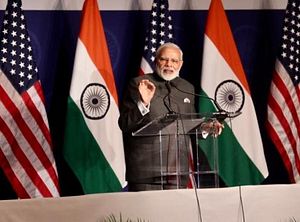Yesterday, Indian Prime Minister Narendra Modi landed at Joint Base Andrews in Maryland for his fifth visit to the United States since taking office just more than three years ago. This time, however, Modi will be meeting a different U.S. president: Donald J. Trump.
The Modi-Trump meeting has been long-awaited and will take place on Monday, June 26. While the U.S.-India relationship made important strides between 2014 and late-2016, Trump hasn’t quite let on a sense of where his policy on India stands.
At the recent Shangri-La Dialogue in Singapore, U.S. Secretary of Defense Jim Mattis spoke fondly of India as a strategic partner for the U.S., even quoting Modi’s words on freedom of the seas. And Trump’s national security adviser, H.R. McMaster, stopped by in New Delhi for high-level meetings following a similar trip to the United States by his Indian counterpart Ajit Doval. Despite these meetings and beyond two friendly phone calls between Modi and Trump, it remains unclear where U.S.-India relations are headed from here.
The good news for bilateral ties has been that the Obama-era rapprochement paid dividends in the sense that a lot of U.S.-India initiatives appeared to have kept running on autopilot. For instance, one of the banner deliverables that is expected out of this Modi-Trump summit is the conclusion of a deal for India to purchase U.S. 22 MQ-9B Guardian drones.
As my colleague Franz-Stefan Gady has discussed, India’s interest in the deal runs into last year and the agreement should represent one of the first major crystallizations of the benefits India enjoys under its new status as a “major defense partner” of the United States (a bespoke status conferred on New Delhi last year).
While the above speaks to the maturity of India-U.S. ties today and the relatively deep institutionalization of the bilateral relationship at the bureaucratic level in both countries, Modi will have quite the task when he meets Trump. Unlike George W. Bush and Barack Obama, Trump hasn’t shown any particular interest in the narrative that has long undergirded U.S.-India rapprochement, from a recognition of India as the world’s largest democracy sharing strategic interests with the United States to New Delhi’s long-sought recognition as a responsible nuclear weapons states.
U.S.-India relations were bogged down by their fair share of disagreements during the Bush and Obama years, but both U.S. presidents buying into the narrative around U.S.-India relations helped keep the overall trajectory stable. After Modi entered office, a bolder foreign policy outlook in New Delhi helped accelerate the strategic rapprochement, leading not only to the 2016 conferment of “major defense partner” status for India from the United States, but also expanded trilateral naval exercises with Japan, an agreement on military logistics exchange, and much more.
Thus, Modi’s big task on Monday, when he will finally meet Trump, will be to make sure that the U.S.-India narrative doesn’t disintegrate in the coming years. Succeeding in this endeavor will require building a personal relationship with Trump (modeling perhaps what Japanese Prime Minister Shinzo Abe was able to accomplish back in February). Beyond this, however, Modi will have to make a case for why the U.S.-India relationship should matter to Trump (and how, if at all, ‘Make in India’ and ‘America First’ can co-exist). In short, when Trump looks at India, he should see something more than just another U.S. trade deficit primed for the ‘America First’ treatment.
The chance for spoilers does seem low, but is non-negligible. Trump’s advisors on trade, including new U.S. Trade Representative Robert Lighthizer, pulled no punches in flagging trade deficits when Vietnamese Prime Minister Nguyen Xuan Phuc visited last month. Modi, too, may come to face a similarly frank pitch on trade, which could kick off a turbulent period in U.S.-India ties.
Modi will no doubt also seek to have India’s voice heard by Trump on issues of regional importance, including the Asian security architecture, the future of Afghanistan, Pakistan’s continued support for cross-border militant proxies, and more. Given the higher-level questions about the bilateral leading up to this meeting, however, I’d be surprised if anything particularly revelatory or new emerges on any of these questions.
For now, this first summit between Modi and Trump will be about the ‘big’ questions around U.S.-India relations and about setting the tone for what will no doubt be one of India’s most important diplomatic relationships in the coming years.

































